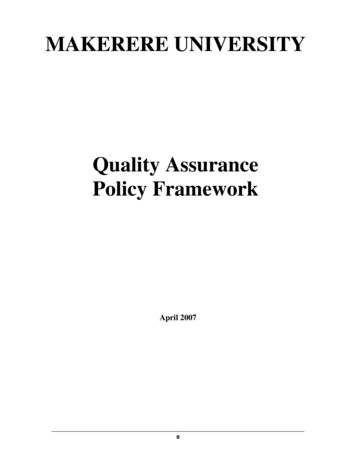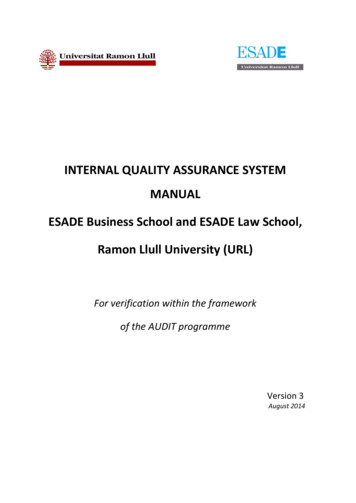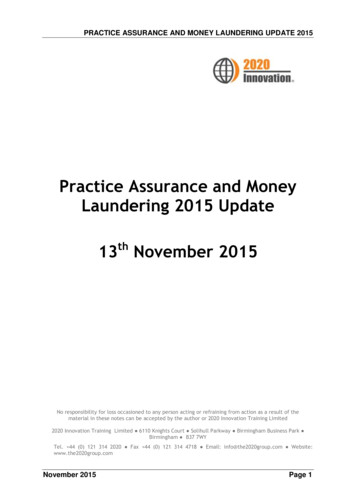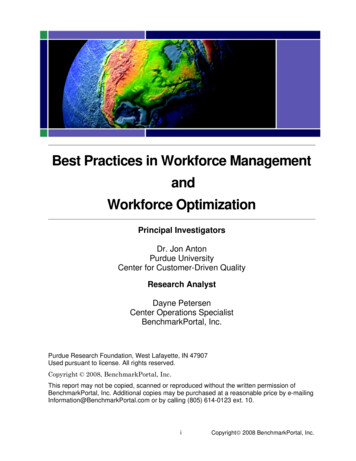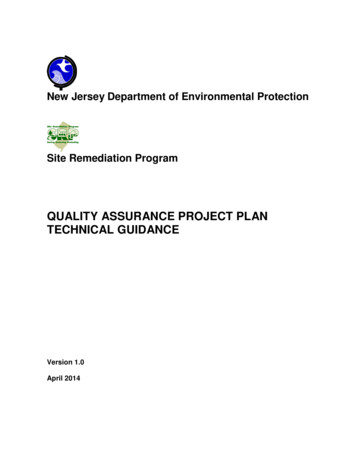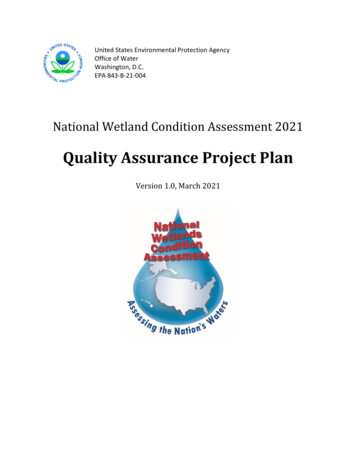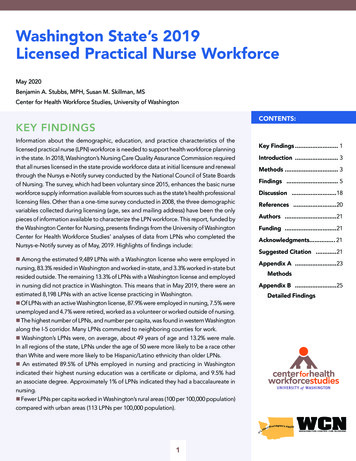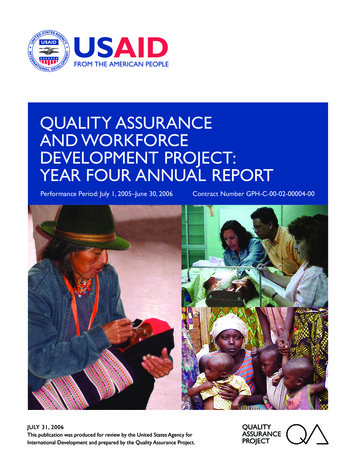
Transcription
QUALITY ASSURANCEAND WORKFORCEDEVELOPMENT PROJECT:YEAR FOUR ANNUAL REPORTPerformance Period: July 1, 2005–June 30, 2006Contract Number GPH-C-00-02-00004-00JULY 31, 2006This publication was produced for review by the United States Agency forInternational Development and prepared by the Quality Assurance Project.QUALITYASSURANCEPROJECT
QUALITY ASSURANCE ANDWORKFORCE DEVELOPMENTPROJECT: YEAR FOURANNUAL REPORTPerformance Period: July 1, 2005–June 30, 2006Contract Number GPH-C-00-02-00004-00July 31, 2006DISCLAIMERThe views expressed in this publication do not necessarily reflect the views of the United States Agencyfor International Development or the United States Government.
Table of ContentsLIST OF FIGURES, TAB LES, AND BOXES. iiABBREVIATIONS. iiiEXECUTIVE SUMMARY. vii1INTRODUCTION . 12INSTITUTIONALIZATION. 1AFRICA .12.1BENIN .12.2ERITREA .32.3LESOTHO.42.4NIGER .52.5RWANDA.92.6SOUTH AFRICA .152.7SWAZILAND.192.8TANZANIA.202.9UGANDA .26EASTERN EUROPE.292.10 RUSSIA .29LATIN AMERICA AND THE CARIBBEAN .352.11 ECUADOR.352.12 HONDURAS.392.13 NICARAGUA .432.14 P ERU.483CORE TECHNICAL ACTIVITIES. 493.13.23.33.43.53.63.73.84COLLABORATIVES DOCUMENTATION AND EVALUATION .49COMPUTER-BASED TRAINING.52MAINSTREAMING HEALTH SYSTEMS STRENGTHENING INITIATIVE .54OPERATIONS RESEARCH .57REGULATORY APPROACHES TO QUALITY.63TRAINING.64TECHNICAL LEADERSHIP/COMMUNICATION .64WORKFORCE DEVELOPMENT.68USAID STRATEGIC OBJECTIVES . 694.14.24.34.44.54.6SO1 P OPULATION .69SO2 SAFE MOTHERHOOD .70SO3 CHILD HEALTH .74SO4 HIV/AIDS.78SO5 INFECTIOUS DISEASE : MALARIA .81SO5 INFECTIOUS DISEASE : TUBERCULOSIS .82QAP Year Four Annual Reporti
List of Figures, Tables, and BoxesFigure 1. Niger: Proportion of Malaria and Pneumonia Cases Managed According to Standards, 14 PHISites, Jan 04-Dec 05 .6Figure 2. Niger: Average % Compliance with Pneumonia, Malaria, ETAT Case Management Standards,15 PHI Sites, Jan-June 06.6Figure 3. Rwanda: Partner Testing of ANC Clients, Old and New Sites in the PMTCT Collaborative . 11Figure 4. Rwanda: Delivery of Nevirapine at Delivery, Old Sites in the PMTCT Collaborative . 11Figure 5. Rwanda: Percentage of Patients on ART with 95% Adherence, 13 Sites. 12Figure 6. Rwanda: Percentage of ART Patients Lost to Follow-up at Gihundwe Health Center. 13Figure 7. Tanzania: Pediatric AIDS Care Improvement in Five Hospitals . 21Figure 8. Tanzania: Reduction in Average Number of Days Experiencing Stock-outs, All 15 FamilyPlanning Collaborative Sites. 25Figure 9. Russia: HIV-TB Results in Engels, Saratov Oblast . 33Figure 10. Russia: Patient Access and Support Results in Orenburg City, Orenburg Oblast. 33Figure 11. Honduras: Compliance with Prenatal Care Standards. Four Departments, 2005-2006. 40Figure 12. Honduras: Compliance with Labor Monitoring Standards (Correct Use of the Partograph). FiveDepartments, 2005-2006 . 40Figure 13. Honduras: Compliance with Standards for Case Management of Pneumonia. FourDepartments, 2005-2006 . 41Figure 14. Nicaragua: Case Fatality for Pneumonia and Diarrhea in Phase I Hospitals . 44Figure 15. Nicaragua: Case Fatality for Severe Asphyxia in Three PHI Hospitals . 45Table 1.Table 2.Table 3.Table 4.Table 5.Niger: Technical Content of EONC Collaborative Cycles.8Rwanda: Best Practices for Increasing Partner Testing in PMTCT . 10Tanzania: Expansion of PHI/Pediatric AIDS Collaborative. 21Tanzania: PHI Collaborative Activities, May 2005-April 2006 . 22Tanzania: Training of Trainers and Transfer Training of Infant Feeding Counselors, May 2005May 2006. 23Table 6. Tanzania: Summary of Family Planning Collaborative Activities, July 2005-May 2006 . 24Table 7. Ecuador: Selected Indicators from the EOC Collaborative . 36Table 8. Nicaragua: Compliance with Key EOC Process Standards in 14 SILAIS, 2003-2005 . 45Table 9. Nicaragua: Compliance with Key EOC Process Standards in Four Empresas MédicasPrevisionales, 2004-2005. 47Table 10. Current QAP Collaboratives, June 2006 . 50Table 11. Status of Operations Research Studies, June 2006 . 57Table 12. QAP Technical Publications, 7/1/05-6/30/06 . 65Table 13. QAP Participation in Briefings and International Conferences, 7/1/05-6/30/06. 66Box 1.Box 2.Box 3.Box 4.iiFacility Results in South Africa: Barberton Hospital in Mpumalanga Province . 16Facility Results in South Africa: Driefontein Health Center in Mpumalanga Province. 17Russia: Illustrative Results from Site Teams. 32Angola: Health System Strengthening Assessment Findings . 55QAP Year Four Annual Report
RMHRSAHSAIBPIDUIECIHIIMCIIMNCIIPTArtemisinin Combination TherapyAplahoue-Dogbo-Djakotome (Benin)Accessible, Feasible, Affordable, Sustainable, and SafeAmerican International Health AllianceAIDS/HIV Integrated Model District ProgrammePrograma de Atención Integral de la Mujer y AdolescenciaIntegrated child health activities at the community level (Atención Integral a laNiñez en la Comunidad)Active Management of Third Stage of LaborAntenatal CareAntiretroviral TherapyAntiretroviralBehavior Change CommunicationComputer-Based TrainingCritical Care PathwayCompact Disc-Read Only MemoryContinuous Quality ImprovementCounseling and TreatmentCounseling and Treatment Center (Tanzania)Department of Health (South Africa)Directly Observed TherapyDivision for the Promotion of Quality Services (Rwanda)Direction de la Santé de la Reproduction (Niger)Directorate of Healthcare (Rwanda)Elizabeth Glaser Pediatric AIDS FoundationEmpresas Médicas PrevisionalesEssential Obstetric CareEssential Obstetric and Newborn CareEmergency Triage, Assessment, and TreatmentFamily Care Internationa lFamily Health InternationalFamily PlanningGlobal Drug FacilityGlobal Fund for AIDS, Tuberculosis and MalariaGlobal Health CouncilHepatitis C VirusHuman Immunodeficiency Virus/Acquired Immunodeficiency SyndromeHuman ResourcesHuman Resources DevelopmentHuman Resources ManagementHealth Resources and Services AdministrationHealth Service AreaImplementing Best PracticesIntravenous drug userInformation, education, and communicationInstitute for Healthcare ImprovementIntegrated Management of Childhood IllnessIntegrated Management of Newborn and Childhood IllnessIsoniazid Preventive TherapyQAP Year Four Annual Reportiii
SRCMivInternational Society for Quality in Health CareInfant and Young Child FeedingJohn Snow Inc.Kilimanjaro Christian Medical CentreLatin America and CaribbeanMunicipality of Santa Rita of Copan (Honduras)Maximizing Access and QualityMaternal and Child HealthMinistry of the Family (Nicaragua)Ministry of Health (Nicaragua)Maternal Mortality RateMaternal Mortality Reduction InitiativeMinistry of HealthMinistry of Health and Social Development (Russia)Ministry of Health and Social WelfareManagement Sciences for HealthNational Malaria Control Center (Zambia)National Department of Health (South Africa)Nongovernmental OrganizationNational Tuberculosis Control Program (Swaziland)National Tuberculosis ProgramOffice of U.S. Foreign Disaster AssistanceOffice of the Global AIDS CoordinatorOpportunistic InfectionsOutpatient DepartmentOperations ResearchOrphans and Vulnerable ChildrenPan American Health OrganizationPobe-Adja-Ouere-Ketou (Benin)Pneumocystic Carini PneumoniaProvincial Department of Health (South Africa)Plan, Do, Study, ActPresident’s Emergency Plan for AIDS ReliefPediatric Hospital ImprovementPartners for Health Reform Plus ProjectProjet Intégré de Santé FamilialePersons Living With HIV/AIDSPrevention of Mother-to-Child Transmission of HIVNational Malaria Control Program (Rwanda)Prevention of Postpartum Hemorrhage InitiativePublic-Private MixProtecting Families Against AIDSPopulation Services InternationalQuality AssuranceQuality Assurance ProjectQuality ImprovementQuality of CareNorth Atlantic Autonomous RegionSouth Atlantic Autonomous RegionReproductive and Child Health Service (Tanzania)Referral Care ManualQAP Year Four Annual Report
RDTRPM HOLDURCUSAIDUSGVCTWDWHOWHO/AFRORapid Diagnostic TestRational Pharmaceutical Management Plus ProjectSkilled Birth AttendantDepartmental Secretariat of Health (Bolivia)Local Integrated Health Care System (Nicaragua)Strategic ObjectiveSecretariat of Health (Honduras)Sexually Transmitted InfectionSociety for Women and AIDS in AfricaTechnical Assistance and Support Contract 2/Global HealthTuberculosisTreatment and Research AIDS Center (Rwanda)United Nations Fund for Population ActivitiesUnited Nations Children’s Emergency FundUganda Program for Human and Holistic DevelopmentUniversity Research Co., LLCUnited States Agency for International DevelopmentUnited States GovernmentVoluntary Counseling and TestingWorkforce DevelopmentWorld Health OrganizationRegional Office for Africa of the World Health OrganizationQAP Year Four Annual Reportv
Executive SummaryIn its fourth contract year, the Quality Assurance and Workforce Development Project (QAP) sawexpansion in field activities in Ecuador, Honduras, Nicaragua, Niger, Russia, Rwanda, and Tanzania; thestart-up of new country programs in Lesotho, Swaziland, and Uganda; and the close-out of support toMalawi and Eritrea. New technical work was initiated related to expanding and better integratingnewborn care within maternal care; mainstreaming tools and approaches for health systems strengtheningwithin USAID’s health portfolio; and applying QA methods to strengthen programming for orphans andvulnerable children.Improvement collaboratives continued to be the dominant technical approach applie d in QAP-supportedfield activities, largely due to the strength of the results produced through collaboratives and theireffectiveness as a methodology for systematic scale -up of best practices. In its first four years, QAP hasimplemented 24 collaboratives in 11 developing countries. Currently, the project is supporting 13collaboratives in eight countries. It is worth noting that collaboratives in both Niger and Uganda arebeing implemented at national scale, with participating sites in almost all districts or regions.The launch of the essential obstetric and newborn care (EONC) collaborative in Niger is a particularlyimportant achievement given that maternal and newborn mortality rates in that country are among thevery highest in the world. Newborn survival is integrally related to the quality of maternal pregnancy anddelivery care, but in practice the newborn is often ignored after a skilled delivery. Yet, proven low-costinterventions can have a dramatic impact on newborn survival. The new EONC collaborative isleveraging the existent pediatric hospital improvement collaborative infrastructure and capacity tointegrate known best maternal and newborn care practices into routine care at all three national maternityhospitals, four of the five regional hospitals, and 64% of Niger’s district hospitals.QAP’s program in South Africa continued to support the National Department of Health and ProvincialDepartments of Health in expanding and improving quality of counseling and testing services, preventionof mother-to-child transmission (PMTCT) of HIV/AIDS, and the continuum of care and treatment forpatients with HIV/AIDS. Quality improvement (QI) activities were re-introduced in North West Provincewith the appointment of a new provincial QA coordinator. QAP launched a national antiretroviraltreatment collaborative with the Ministry of Health of Uganda, with 57 sites in 91% of districts. InTanzania, the Ministry of Health funded the extension of the pediatric AIDS and hospital improvementcollaborative to 15 new hospitals in three northern regions. The family planning collaborative, involving15 sites, ended with its final learning session in July 2006.Building on solid improvements achieved in sites participating in the HIV/AIDS care, treatment, andsupport collaborative initiated in December 2004 in four territories of the Russian Federation, a newcollaborative was initiated in 2006 to improve family planning services for persons with HIV/AIDS.This year, QAP played a catalytic role in changing Ecuador’s national maternal health policies to adoptactive management of the third stage of labor as part of the country’s official norms. To complement thework of the EOC collaborative, which is being implemented with provincial health authorities in 13 of thecountry’s 22 provinces, QAP is now supporting the Ministry of Health to launch a national spreadcollaborative to extend the practice of active management to all facilities attending births in the other nineprovinces where it has not been formally introduced. In Honduras, QAP’s program tripled in size as aresult of the USAID Mission’s request that QAP expand its technical support to integrate qualityassurance with health sector reform initiatives on decentralization and pay-for-performance and withUSAID support for reproductive and child health services. In Nicaragua, QAP completed its assistance toPROFAMILIA, which has consolidated its QA program, and added a new area of technical support to theMinistry of Health in developing standards for HIV counseling and testing and improving service qualityin the expanding PMTCT program.QAP Year Four Annual Reportvii
QAP’s ongoing program of documentation, evaluation, and operations research related to collaborativeshas yielded a broad set of data on the experiences of all the collaboratives conducted to date. An intensiveweek of sharing of experiences in implementing collaboratives took place in June 2006, with field stafffrom nine countries and headquarters staff analyzing lessons in planning, starting up, and managingcollaboratives. A series of field evaluations of QAP-supported collaboratives was planned, beginning withTanzania in July 2006. Since most collaboratives rely on self-assessed data on compliance with standardsto measure improvement over time, QAP initiated this year a new study on the validity of the selfgenerated data in the EOC collaborative in Ecuador. A similar study to measure the sequential validity ofself-assessment in the pediatric hospital improvement (PHI) collaborative in Tanzania is in planning.A new study to develop and field test health work job aids to improve rapid testing for malaria was startedin Zambia. Work progressed on 20 other operations research studies during the year: four were completedand results published; another six have final reports in editing. Studies completed during the year includethe analysis of questions added to the national demographic and health survey in Ecuador on factorsinfluencing site of delivery and three studies emerging from the safe motherhood research data sets fromBenin, Ecuador, Jamaica, and Rwanda. Other studies in the final data analysis or reporting phases includethe research in Nicaragua to apply simpler tools for assessing skilled birth attendants’ (SBAs’)competence to a national sample of health providers, the Kenya field test of the updated integratedmanagement of childhood illness (IMCI) computer-based learning tool, and a rapid assessment of ARVtreatment services in South Africa. Subcontractor Initiatives Inc. completed two major workforce-relatedstudies: one on the human resources implications of HIV/AIDS services scale -up in Rwanda and the otheron performance-based incentives for health workers in Zambia.During Year Four, QAP published six operations research reports, one technical report, and oneevaluation report. Staff delivered six presentations to USAID and cooperating agencies, and QAP workwas presented at ten international and regional conferences. Two manuscripts were submitted to TheLancet in May 2006 for consideration for the journal’s upcoming maternal mortality reduction series, andanother five manuscripts were either drafted or submitted for publication to various journals. The QAPcollaborative extranet was further developed, and the appearance and functionality of the data graphingmodule were modified to improve usability. In Rwanda, 15 teams in the PMTCT collaborative used theQAP Eextranet to enter and view data and improvement reports.viiiQAP Year Four Annual Report
1 IntroductionThis annual report of the Quality Assurance and Workforce Development Project, widely known as theQuality Assurance Project or QAP, describes the activities and results of the contract during the fourthproject year, covering the period July 1, 2005 to June 30, 2006.QAP’s objectives are to:§Build capacity in countries to develop and sustain quality assurance and workforce improvementactivities§Assist countries to achieve demonstrable results in quality of care and outcomes§Strengthen USAID programming under its Global Health Strategic Objective (SO) programsthrough quality assurance (QA) approaches, methods, and tools§Carry out research to develop and test new QA and workforce development approaches andmethods§Provide leadership in the technical development of the quality improvement field and inadvocacy of the essentia l goal of high quality of care worldwide.QAP is managed by University Research Co., LLC (URC). Small business subcontractors Initiatives Inc.;EnCompass, LLC; ARTT International; and Dragonfly Communications also contributed to theimplementation of QAP activities during the past year.The major sections of this report reflect the main components of the contract scope of work.Institutionalization refers to the project’s long-term activities to support the development ofinstitutionalized QA programs in USAID-assisted countries. Reports of the past year’s field activities arepresented alphabetically by geographic region and country. These are followed by descriptions ofprogress achieved under the project’s core technical activities and USAID strategic objectives.2 InstitutionalizationAfrica2.1BeninBackgroundIn Benin, both antenatal care coverage at 80% and skilled birth attendant coverage at 65% are higher thanin many other African countries. Despite relatively better access to care, the maternal mortality ratio hasremained static in the past decade, and Benin still has one of the highest maternal mortality rates in theworld at 475 maternal deaths per 100,000 live births. Persistent high maternal mortality, despite relativelygood access to skilled care, inevitably raises questions about the quality of care and highlights the need tomove beyond the policy level to more effective program implementation. The recently published“National strategy for the reduction of maternal and newborn mortality” identif ies poor quality care as amajor contributor to poor heath outcomes.Since late 2004, QAP has been working with the Ministry of Health to support an essential obstetric carecollaborative in two health districts: Pobe-Adja-Ouere-Ketou (PAK) and Aplahoue-Dogbo- Djakotome(ADD). The aim of the collaborative is to improve the quality of maternal and newborn care and todevelop an operational model which can be spread to other districts. There are 15 facilities in thecollaborative: three regional hospitals, two district hospitals, and five health centers and large health postsin each district. QAP’s key partner in the collaborative is the Division of Family Health in the MinistryQAP Year Four Annual Report1
of Health (MOH) but other stakeholders who are actively involved in program implementation are theUnited Nations Fund for Population Activities (UNFPA), the United Nations Children’s Fund (UNICEF),and Intrahealth. UNFPA and UNICEF are providing both technical support and equipment in the twodistricts, and Intrahealth has supported development of national protocols and training curricula foressential obstetric and newborn care.Activities and ResultsEssential Obstetric and Newborn Care Improvement CollaborativeThe third learning session of the collaborative was held in January 2006, followed by a third round ofsupportive supervision. Priority technical areas addressed by the collaborative have included use of thepartograph, active management of the third stage of labor (AMTSL), data use, and antenatal care (ANC).In each partic ipating facility, quality improvement teams of on average four to eight members have beenformed (often the majority of the staff in the smaller facilities). Team members (midwives, nurses, ordoctors) from each facility serve as improvement coaches and have helped staff define specific qualitybarriers that can be addressed in each facility. For example, certain facilities interviewed clients todiscover that privacy was an important concern for many women, and as a result installed curtains in thelabor wards and antenatal consultation rooms. Other facilities, identifying through their self-monitoringthat compliance with ANC standards was poor, decided to change and improve their ANC cards. (Thecards serve as a job aid for the provider as well as facilitating the recording of each ANC consultation.)As a result of these efforts, there have been significant and sustained improvements in several areas, mostnotably, in AMTSL and partograph use. Between February 2005 and January 2006, data collected in the10 peripheral sites (health centers and posts) showed that:§The proportion of ANC visits meeting identified standards rose from 58% to over 90%§The proportion of partographs completed according to standards rose from 56% to 82%§The proportion of deliverie s in which AMTSL was implemented increased from 2% to over 80%.This progress is still fragile, however, and additional work is necessary, particularly in specific technicalareas such as newborn care, infection prevention, and case management of obstetric and newborncomplications. Hospitals have demonstrated more difficulties in making quality improvement changesthan have lower level facilities.Since February 2006, however, coaching support to the 15 teams participating in the collaborative has notbeen possible because of a lack of transport and the departure of QAP’s coordinator to the new PISAFbilateral project. In May 2006, Maina Boucar, Sabou Djibrina, and Mandy Rose visited Benin torevitalize the collaborative and to explore investing additiona l SO3 core funds to strengthen newbornhealth and to link essential obstetric and newborn care (EONC) with services to prevent mother-to-childtransmission of HIV (PMTCT), and link facility-based services with community care. Benin had beenidentified as a potentially suitable country for this additional investment because of the presence of anexisting collaborative, a national PMTCT service, and facilities which are comparatively more accessibleto the population than in other countries.The visiting QAP team found that major progress has been achieved at the health center/post level andthat this progress has been sustained in some facilities without regular supervision from collaborativestaff. Nevertheless, much more remains to be done. Providers observed by the QAP team were notcounseling women about danger signs or birth planning during ANC, delivery ward hygiene was poor,and there was no preparation for potential emergency admissions, despite all three areas being part ofMOH policies. Moreover, maternity wards were full of equipment that was dirty or which was notworking for lack of simple maintenance. There was an almost universal neglect of the needs of newborns.2QAP Year Four Annual Report
Although the MOH does have in place the policies and protocols to advance newborn health, there is ahuge need to support the implementation of best practices to improve EONC and care of the sick andvulnerable newborn. The MOH Family Health and PMTCT directorates are interested in the expandedEONC collaborative concept because newborn health and better integration between PMTCT andmaternal and newborn health services are both MOH priorities. To date there has been little experience inBenin with implementing programs to improve newborn health.The team met with staff of PLAN International, which is working in the ADD district. PLAN’s healthactivities include supporting PMTCT at the facility and community level and community activities innutrition and integrated management of childhood illness.Directions for FY07In the coming year, the collaborat
QUALITY ASSURANCE AND WORKFORCE DEVELOPMENT PROJECT: YEAR FOUR ANNUAL REPORT Performance Period: July 1, 2005-June 30, 2006 Contract Number GPH-C-00-02-00004-00 . QAP Quality Assurance Project QI Quality Improvement . QAP's program in South Africa continued to support the National Department of Health and Provincial
